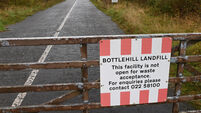THE shooting of two teenage brothers by the RIC and the IRA’s execution of three British soldiers the same day show how bloody the conflict was in Co Clare.
Following early Mass on the morning of Sunday, February 20, 1921, brothers Aidan, 18, Thomas, 17, and Cecil O’Donovan, 14, left their home in Thomondgate, Co Limerick.
The trio set off for Parteen just across the county border in southeast Clare. They were planning to spend the day searching for birds’ nests.
On their journey they met their cousin Ben O’Donovan who decided to join them on their adventure.
Around 12pm, the four arrived at Blackwater Mill and after exploring the ruin without finding any nests decided instead to play in the fields outside. Absorbed with their games, the four boys did not pay any attention to two Crossley Tender lorries laden with British troops that were approaching from Limerick. The advancing British patrol was under the command of RIC district inspector John Greally and Captain David Sturrock of the British Army.
Sturrock, an intelligence officer, later claimed that he had been tipped off by a spy that an IRA unit were drilling in the grounds of the mill and it was on the foot of this information that the convoy had been sent to investigate.
Inspector Greally and Captain Sturrock moved up to investigate. The British officers later claimed they had seen a large number of IRA Volunteers fleeing the mill as they approached.
Greally and Sturrock both claimed they only opened fire after calling upon the fleeing Volunteers to surrender. The truth is that there had been no IRA Volunteers present and that O’Donovan boys had no chance to surrender before the RIC opened fire with fatal consequences.
A party of RIC constables and Black and Tans under the command of Sergeant James Horan, an infamous RIC officer from Co Mayo who had been involved in several controversial killings in Limerick,
immediately opened fire.
Aidan O’Donovan was shot in the chest and died a few minutes later. His older brother Cecil was shot through the forehead and died instantly.
Ben O’Donovan managed to escape through the grounds of the mill while Thomas O’Donovan was taken prisoner.
The shooting only stopped after Captain Sturrock of the British army personally intervened to prevent the RIC killing the two surviving O’Donovan boys.

A British army inquiry was held at the New Barracks (now Sarsfield Barracks) Limerick on February 22. It was very clear that no order to open fire was given by either Captain Sturrock or Inspector Greally.
Instead it was the group of RIC constables and Black and Tans led by Sergeant Horan who were responsible for what became known as the Blackwater Massacre.
In his evidence to the inquiry, Thomas O’Donovan said that while he saw the lorries arriving he did not hear any order to halt or surrender before Sergeant Horan and the members of the RIC opened fire killing his two brothers.
Although the O’Donovan brothers were innocent civilians slaughtered without warning, the history of the British army’s Sixth Division , published a few years after the War of Independence, invented the claim that the O’Donovans had been armed with hand grenades and revolvers when shot.
This contrasts with the contemporary British army investigation which found that the brothers were unarmed civilians.
Soldiers executed
IN AN unrelated incident the following day at the opposite, northern end of the county, the IRA executed three British soldiers from the Oxford and Buckinghamshire light
Infantry.
The trio were Private Thomas Mullett, Private William Walker and Private David Williams who were all stationed at the Strand Barracks, Limerick. On the morning of February 22, their bodies were discovered by a farmer on the Woodford to Cahir road near the shores of Lough Attorick near the Clare-Galway border.
The three soldiers had been executed by the IRA’s East Clare Brigade. Each been shot in the head. One of them had a label hung around his neck which read “Spies. Tried by courtmartial and found guilty. All others beware.”
A century later, mystery still surrounds the fate of these three British soldiers, why they had left their barracks in Limerick, and how they came to be captured by the IRA so far from where they were stationed.
Naturally (as in almost all such cases) there is almost complete disparity between British accounts and those of republican veterans and local people.

According to the Oxford and Buckinghamshire Light Infantry’s Regimental Chronicle: “The three had been missing from Strand Barracks since February 13.”
The RIC report on their deaths simply recorded that: “These soldiers were supposed to have been deserters.”
IRA veteran Sean Moroney states that the three were captured on or about February 13 and were held for about a week before being court-martialled and executed: “About this time three men who claimed they were deserters from the British Army, were arrested by Volunteers in my Battalion area. During the trial it was proved that they had tried to, and did, in fact keep in contact with their own forces.
“The result was that they were found guilty of being spies and sentenced to death. The sentence was duly carried out.”
If the British accounts were true and the three soldiers had deserted and wanted to go back to England there is no logical explanation for their decision to travel northwards 32km cross-country on foot through east Clare which was one of the most active IRA brigade areas at the time.
The quickest and easiest route for British soldiers stationed in Limerick to return to their homes in England would have been for them to have walked to the Limerick docks and simply boarded a ship bound for Britain either as stowaways or using a false identity.
It would have been impossible for the three to have made their journey from Limerick to north Clare without being confronted en route by either a British or IRA patrol.
It seems more plausible that the men rather than deserting from their barracks in Limerick instead travelled to their regiment’s second barracks in Tulla on a British army lorry and set out on foot from there.
British army records show all three men were paid until February 22, the date that their bodies were discovered.
The British army did not pay wages to soldiers who had been absent without leave for over eight days and who were presumed to have deserted.
This strongly suggests that Mullett, Walker, and Williams were still serving soldiers on active duty when they were captured and executed by the IRA.
In the later stages of the War of Independence the British army began using soldiers posing as deserters to gather intelligence about the IRA and the likelihood is that these three “deserters” were actually engaged on an intelligence gathering mission when they were captured and sentenced to death by the IRA a century ago.
- Pádraig Óg Ó Ruairc has a PhD in history and has written several books about the War of Independence


CONNECT WITH US TODAY
Be the first to know the latest news and updates














